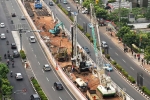Download our latest report
At this time last year, Asia Pacific CEOs’ optimism was at an all-time high. They grounded their hope in an economic rebound based on the fact that most countries were reopening for business. Asia Pacific was increasingly seen as a beacon for the world’s growth, buoyed by strong domestic demand and a gradual rebalancing of trade.
A year on, we’re seeing a reversal of this confidence. A complex series of challenges are threatening growth opportunities, driving a state of disequilibrium in Asia Pacific. This is the new reality: heightened geopolitical tensions, rampant inflation, supply chain fragility, new workforce challenges and the accelerating pressure for action on Environmental, Social and Governance (ESG) issues.
Against this backdrop, 4,410 CEOs worldwide, including 1,634 in Asia Pacific shared their insights for our 26th Annual Global CEO Survey. Sentiments are clear: in the short-term manage external risks to drive profitability to survive. Simultaneously, in the longer term, transform to thrive. We call the combination of these two mandates the dual imperative.
Executing the dual imperative is a complex undertaking. It requires businesses to accelerate innovation while delivering short term efficiency. It places pressure on the CEO agenda to collaborate broader and deeper than ever before as part of a revamped business model. CEOs who - comprehensively understand the challenges, redefine priorities around value creation, build a differentiated culture of empowerment and pragmatically leverage a broad suite of stakeholders - are primed for success.
Leading has never before been more important. It can redefine both business relevance and the CEO’s legacy. The time to lead is now.
Asia Pacific highlights
In the new reality, Asia Pacific CEOs:
… have reversed their prior optimistic sentiment
- 69% believe global economic growth will decline compared to last year when 76% felt growth would improve.
- However, compared to global peers, Asia Pacific CEOs are relatively less pessimistic about prospects of global growth and have a more optimistic view of their own territory’s growth.
… prioritise short-term profitability
- Similar to global peers, inflation, macroeconomic volatility and geopolitical conflict are the top three risks Asia Pacific CEOs will focus on in the next 12 months. ESG-related risks remain a focus for the longer term.
- In response to near-term challenges, close to half will focus on reducing operating costs, diversifying portfolio and raising prices in the short term, as opposed to workforce-related initiatives (~8-16%).
… need to transform their business to remain viable
- 53% (14% more than global CEOs) believe their current business models will not survive within the next decade.
- Asia Pacific CEOs recognise the dual imperative: to balance execution of short-term profitability and long-term transformation.
… see challenges in their people experience and culture
Consistent with global peers:
- Only 41% believe current employee behaviours are mostly aligned to company values and direction.
- About half do not often encourage debate or dissent, nor do they tolerate small-scale failures.
- 73% do not often make independent strategic decisions for their function or division.
… place a premium on broad collaborations to drive business value
Compared to global CEOs, Asia Pacific CEOs are up to 6% more likely to forge partnerships outside established stakeholder groups.
The goal of these partnerships is primarily to create new sources of value, rather than to solve societal challenges.
We suggest five actions for Asia Pacific CEOs to manage these complexities and successfully drive transformative leadership:
Gather a diverse range of insights to help leaders understand the current forces shaping the business environment and make more informed decisions.
Mobilise and empower executive leadership to take action and make decisions that support the business' long-term strategic goals and resilience.
Use a disciplined approach focused on capabilities to balance profitability, transformation and growth.
Adapt leadership approach to address the concerns and aspirations of employees.
Embrace a collaborative mindset and seek out alliances to achieve sustained outcomes.

Today’s tensions
driving tomorrow’s transformation
A PwC study of 1,634 Asia Pacific CEOs (as part of our Annual Global CEO Survey) has shed light on what keeps CEOs in the region awake at night. Their sentiments are clear: the combination of challenges they face has placed businesses at a turning point which requires a dual imperative—focusing on the ‘here and now’ profitability challenges while reinventing the business for future viability. Successfully managing this balance today is the path to competitive advantage tomorrow.
Globally, CEOs are wrestling with a series of questions that are relevant to successfully executing the dual imperative. Our regional snapshot ‘26th Annual Global CEO Survey - Asia Pacific: Leading in the new reality’ explores the unique challenges and opportunities for business leaders in our region. We also suggest pragmatic responses based on PwC’s research and experience supporting business leaders.
Reversal of prior optimistic sentiment
Survey respondents in our region are broadly pessimistic: 69% believe global economic growth will decline over the next 12 months. This shows a stark reversal of last year’s result when a large proportion (76%) anticipated improvement in global growth.
Asia Pacific CEOs’ optimism in global economic growth is at a ten year low
Q: How do you believe economic growth (i.e. gross domestic product) will change, if at all, over the next 12 months in the global economy?
Source: 26th Annual Global CEO Survey
CEOs in our region are bracing for the impacts of a potential global recession, continued high inflation and volatile commodity prices. Soft global demand will weigh on export-oriented economies including Hong Kong SAR, Malaysia, Singapore, Taiwan and Vietnam. China—a growth engine for the region—will likely experience slower-than-typical growth due to macro and long-to-medium term economic and other policies. The International Monetary Fund (IMF) has cut their prior growth forecasts for Asia and the Pacific to 4.3% in 2023, down by 0.8%.
Despite the deterioration in CEO confidence, Asia Pacific remains one of the most optimistic regions about global growth - comparable to other emerging economies including Africa and Latin America. Country levels of confidence vary, reflecting consumer and business sentiment in economic fundamentals. The most optimistic countries are China (42%) and Indonesia (29%) whose CEOs believe the global economy will improve. Several markets in the region exhibit greater pessimism reflecting their CEOs view of the enduring impact of global macroeconomic factors: Singapore (6%), Australia (8%), South Korea (10%), New Zealand (13%) and India (13%).
Asia Pacific CEOs are also far less pessimistic about prospects of their own territories compared to global counterparts. The growing emphasis on national interests over global ones represents an acceleration of trends underway. However, the fundamentals of the region continue to be bolstered by trade liberalisation (for example through the Regional Comprehensive Economic Partnership) and markets welcoming foreign direct investment.
CEOs in larger Asia Pacific territories show the highest level of optimism in their nation’s economic prospects compared to global CEOs: China (64%), India (57%) and Indonesia (50%). China’s health and economic policy measures appear to promote its gradual recovery by the second half of 2023 and into 2024. At the same time, the global downturn would have less impact on countries whose economic prosperity is buffered by significant domestic demand. This includes Indonesia and India—the latter which is increasingly seen as a complementary manufacturing hub for the region.
Despite the high level of pessimism in global growth, Asia Pacific CEOs are more confident in the prospect of their territories
Q: How do you believe economic growth (i.e. gross domestic product) will change, if at all, over the next 12 months in your territory?
Note: Showing only ‘improve’ responses
Source: 26th Annual Global CEO Survey
Prioritisation of short-term profitability
Asia Pacific CEOs’ pessimism translates into a clear mandate to focus on the ‘here and now’: preserve operating profitability and immediate cash flow generation and defer longer-term value creation.
When asked about threats Asia Pacific CEOs think they will be exposed to over the next 12 months, inflation, macroeconomic volatility and geopolitical conflict stand out, similar to their global peers. CEOs across the region perceive threats differently depending on economic maturities and nuances of their operating environment. Differences are pronounced within the region: Australia and Japan CEOs worry more about cyber risk, while geopolitical conflict is the top threat for CEOs in China, Hong Kong SAR and South Korea.
Perspectives change when considering the medium term (defined as five years). Cyber risk and climate change are seen as more important over this horizon, especially for Australia, China, Malaysia and New Zealand. Climate in particular is progressively impacting operations through a cycle of disruption of supply chains and inventory.
Notably, smaller companies (revenue less than US$100 million) feel least exposed to climate and cyber risks in the short and medium term compared to larger companies. Given their relative investment capacity, smaller companies will likely sharpen focus on the ‘here and now’ profitability to remain viable.
The risks Asia Pacific CEOs expect in five years look different from today, with cyber and climate risk rising in importance
Q: How exposed do you believe your company will be to the following key threats in (a) The next 12 months? (b) The next five years?
Note: Showing sum of ‘highly exposed’ and ‘extremely exposed’ responses
Source: 26th Annual Global CEO Survey
In response to near-term challenges, Asia Pacific CEOs intend to ‘grow’ out of the crisis, consistent with global peers. Along with 48% who have already started cutting operational costs, the same proportion have also looked at diversifying products and raising prices. Most do not plan to tackle cost through workforce-related changes. Only 8% have reduced compensation, while 14% have reduced their workforce. This reflects Asia Pacific CEO’s concerns over attrition which is expected to continue unabated due to the ‘Great Resignation’.
In response to the current environment, Asia Pacific CEOs report cutting costs and spurring revenue growth—but most don’t plan to reduce workforce
Q: What actions, if any, is your company considering to mitigate against potential economic challenges and volatility in the next 12 months?
Source: 26th Annual Global CEO Survey
As geopolitical risks rise, Asia Pacific CEOs are planning to adjust their presence in the current market and/or expand to new markets (53%), adjust supply chains (49%) and diversify their offering (48%) to drive short-term profitability. This is in contrast to global CEOs, who prioritise investment in cybersecurity and data privacy to manage digital risk. This suggests Asia Pacific CEOs prioritise protecting against near-term economic impacts.
Asia Pacific CEOs are adjusting market presence, adjusting supply chains and diversifying their offering in response to geopolitical conflict
Q. What actions, if any, is your company considering to mitigate against exposure to geopolitical conflict in the next 12 months?
Source: 26th Annual Global CEO Survey
Transform to remain viable
In parallel to near-term threats, Asia Pacific CEOs recognise the need to reinvent their businesses to stay relevant amidst large-scale disruptions, and to thrive in a climate-challenged world. This defines the dual imperative: to balance short-term profitability and long-term transformation.
Our survey shows that 53% of CEOs in the region think their companies will not be economically viable within a decade from now, if they continue on their current path (14% higher than global CEOs). More than one in three believe their businesses will not be economically viable within six years.
The urgency is even stronger for South Korea, Japan, China and Hong Kong SAR, where about three quarters of CEOs share this sentiment.
53% of Asia Pacific CEOs believe their companies will not be economically viable in the next decade, if they continue on their current path
Q: If your company continues running on its current path, for how long do you think your business will be economically viable?
Source: 26th Annual Global CEO Survey
Asia Pacific CEOs also understand that their transformation journey must address the disruptive forces impacting industry from multiple fronts. They must keep pace with their customers (56%), appease regulators (54%) and manage labour/skill shortages (50%).
The need for transformation is further highlighted by how Asia Pacific CEOs split their time. Driving current operating performance consumed the biggest share of their time (24%). Given the chance to redesign their ideal schedules, Asia Pacific CEOs would rather spend more time evolving the business and strategy to meet future demands (25%).
This balancing act extends from their calendar to the allocation of corporate resources. Asia Pacific CEOs have made investment into upskilling (73%) their number one priority, followed by automation (71%) and deploying advanced technology (67%). While being a lower priority, Asia Pacific CEOs are more likely than their global counterparts to invest into climate change measures and the metaverse.
Asia Pacific CEOs have made investment into upskilling their number one priority
Q. Which of the following investments, if any, is your company making in the next 12 months?
Source: 26th Annual Global CEO Survey
Challenges in people experience and culture
To successfully execute the dual imperative, Asia Pacific CEOs understand they must place people at the heart of their business— evidenced in the prioritisation of upskilling. What else can they do to engage and inspire their people?
This year’s survey suggests some warning signs which also represent clear areas of opportunity. Similar to their global peers, less than half (41%) of surveyed CEOs in the region think their employees’ behaviours are usually aligned with corporate values and directions (i.e. 81-100% of the time). This suggests their employees feel disconnected from the purpose of their work. The level of misalignment is emphasised when comparing private (38%) and public companies (46%). This reflects the relatively less structured approach for smaller companies in managing their people and culture experience, compared to their more scrutinised public peers.
For employees today, job satisfaction is much more than fair financial reward. Our latest Asia Pacific Workforce survey highlights that workers in the region want more meaningful work. They want to be able to bring their authentic selves to work in an environment consistent with their values.
Asia Pacific CEOs also have questions about the degree of empowerment in their workforce. About half do not often encourage debate or dissent, nor do they tolerate small-scale failures. 73% note their leaders did not often make independent strategic decisions for their function or division. In many organisations, optimal conditions do not appear to be in place for managers and employees to independently cultivate new opportunities or respond to disruptive threats. This indicates a demand for transformative leadership.
Asia Pacific CEOs have questions about the degree to which their organisations are empowered and aligned
Q: For each of the statements below, please indicate how frequently these occur in your company
Source: 26th Annual Global CEO Survey
Desire for broader collaboration to drive business value
The diversity and complexity of today’s business challenges is placing a premium on the ability to collaborate across typical boundaries. Asia Pacific CEOs agree—they are up to 6% more willing than their global counterparts to forge partnerships outside established partner types. When they do collaborate, the goal is primarily to create new sources of value rather than to solve societal challenges with one notable exception: partnership with non-profit organisations (NGOs).
Compared to global CEOs, Asia Pacific CEOs are looking at greater collaboration with government and industry partners - both to drive value and address societal issues (5-6% more).
This is even more pronounced for companies with revenue between US$1 billion and US$10 billion, and with revenues of US$10 billion+. These large enterprises are 7-22% more willing than companies with revenue less than US$100 million to collaborate for societal change. Private companies in Asia Pacific also have a greater willingness to collaborate particularly with government, NGOs and established companies (4-7% more) compared to their public counterparts. This may be due to more limited access to capital and capabilities from a private company perspective.
Asia Pacific CEOs are more likely to forge partnerships than global CEOs
Q: To what extent is your company collaborating with the following groups to: a) Create new sources of value? b) Address societal issues?
Note: showing % to a large extent + to a very large extent
Source: 26th Annual Global CEO Survey
Asia Pacific CEOs prioritise climate change (3% more than global peers) over education (9% less than global peers) when partnering with non-business entities. This trend is most obvious in Australia, China, Japan, New Zealand and Singapore. CEOs of public companies in Asia Pacific also pay more attention to climate change—17% more than private companies. This reflects increasing stakeholder expectations in the race towards Net Zero.
Asia Pacific CEOs are partnering with non-business entities to address sustainable development, DE&I* and climate change
Q: In which of the following areas is your company collaborating with non-business entities (governments, NGOs or academic institutions) to address societal issues?
(*) Diversity, equality and inclusion
Source: 26th Annual Global CEO Survey
Collectively, this indicates the potential for the commerciality of ESG imperatives in the region. Collaboration is a potent accelerator for progress. PwC’s work in ESG strategy development suggests organisations are best able to create business and societal value in tandem when they tackle partnering and ecosystem building with rigour and sophistication. When collaboration is well orchestrated and aligned to capabilities, its potential to address systemic challenges can be accelerated.

Actioning the
dual imperative
Features of the region provide a unique backdrop for Asia Pacific CEOs. Since our last survey, economic activity and trade has continued to elevate the region’s significance on the global stage. And the increasing role of business in society places extra pressure on CEOs in the region.
These all add to a series of complex questions which are generally consistent with global CEO challenges. However, success in Asia Pacific does not come from a ‘one-size-fits-all’ approach. Five actions are needed to build trust and deliver sustained outcomes through transformative leadership.

Gather a diverse range of insights to help leaders understand the current forces shaping the business environment and make more informed decisions. The last year has underscored the importance of appreciating the full suite of risks, challenges and drivers impacting business and their operating environment. Calibrating appropriate levels of pessimism and optimism helps CEOs understand which challenges are new, which ones will endure and those that can be ‘pushed back’. Pragmatically, this means expanding the scale and scope of insights available to the Asia Pacific C-suite. This includes understanding mutually reinforcing themes around sector-specific drivers of volatility, geopolitical sensitivities to supply chains, climate and cyber risks impacting customer preferences, and increasingly—social impact.

Mobilise and empower executive leadership to take action and make decisions that support the business' long-term strategic goals and resilience. Structural challenges in the region will likely endure and shift over time, uniquely impacting various business units and functions. This mandates a more flexible, long-term approach for senior leaders. The C-suite needs to leverage the real-time insights and be enabled to make tactical decisions with agility (for example around products, services and processes). The collective support of CEOs and boards can help guide the C-suite, leveraging their leadership and perspectives, ensuring alignment to both long-term strategy and business resilience.

Use a disciplined approach focused on capabilities to balance profitability, transformation and growth. Specifically, this means taking a capability lens to business drivers to understand where and how to prioritise investment today (for example diversification of product and supply chains) and where not to cut costs or limit capacity (such as critical risk infrastructure and talent) which could put transformation at risk. Key to any strategic refresh and transformation is holistically considering people, ESG and tax/structuring implications in addition to pricing, product and cost levers which have been prioritised in the short term. This approach can be significantly beneficial to CEOs with the capacity to apply it to executing deals during downturns.

Adapt leadership styles to address the concerns and aspirations of employees. Concurrent forces and crises have exposed fragilities in organisational leadership, impacting employee alignment to purpose and resulting in less trust in CEO decision making. It is clear that culture is increasingly fundamental to business success —especially in Asia Pacific where backgrounds, perspectives and experience are highly diverse. CEOs in the region should use this transformational mandate to double down on cultural reinvention: embed purpose through the talent model (including capability building, recruitment and retention initiatives) and align workforce strategy to growth and resilience (by using capabilities as the foundation). Practically, this can be delivered through meaningful initiatives which foster empowerment, inclusion and trust (including leveraging the benefits of hybrid work).

Embrace a collaborative mindset and seek out alliances to achieve sustained outcomes. Part of the region’s relative optimism, both last year and this year, has been driven by similar factors. Significant capital flows into the region from a range of sources; accelerating innovation shifting the dial within and across sectors; and an expansion in the diversity of talent. CEOs in Asia Pacific need to broaden the scope of alliances to include technical, financial, talent and technology—and link these to capabilities. Doing so can help efficiently amplify what the business does best—setting itself up to successfully transform and define its relevance in the long term.
The task for CEOs is a daunting one. A more complete view of challenges and opportunities requires balancing the dual imperative: short-term profitability with a revamped view of value, alliances and culture supporting long-term growth. Leaders that do so have the best chance of building trusted, resilient and profitable businesses in the future. Now—more than ever—is the time for CEOs to demonstrate leadership in the new reality.

Want to take “26th Annual Global CEO Survey - Asia Pacific: Leading in the new reality” with you?
About the survey
PwC invited CEOs in the Asia Pacific region to participate in our 26th Annual Global CEO Survey from October to November 2022. We collected 1,634 responses from Asia Pacific.
Territories covered are Australia, Bangladesh, Cambodia, China, Hong Kong SAR, India, Indonesia, Japan, Malaysia, Myanmar, New Zealand, Philippines, Republic of Korea, Singapore, Sri Lanka, Taiwan, Thailand and Vietnam.
Notes about interpreting charts
Throughout this report, not all figures in bar and stacked bar charts will add up to 100% as a result of rounding percentages and the decision in certain cases to exclude the display of ‘neither/nor’, ‘other’, ‘none of the above’ and ‘don’t know’ responses.














